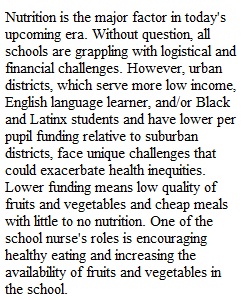


Q For this assignment, you will complete Critical Thinking Activities based on your Chapter 1 and Chapter 12 readings in Williams' Basic Nutrition and Diet Therapy. Please review the Critical Thinking prompts below providing a response for each that is at least 150 words in length. Your responses should be well-written, in your own words, and submitted via an upload below using a Word or Google document. If you have questions about formatting or how to cite your sources, please review the IOT Writing Guide and APA Download IOT Writing Guide and APAguidelines. If you have any questions, please reach out to your instructor! ________________________________________ Week 6: Critical Thinking Activities 1. What are some of the nutritional challenges facing a school nurse at an urban elementary school? How can you provide nutrition education and wellness promotion to this patient population? 2. An 80-year-old woman has had a poor diet for the past 3 months. The patient has been diagnosed with anemia. What could be the cause of the anemia? 3. A resident in a nursing home has severe rheumatoid arthritis and very deformed hands. She has been served a baked potato, salad with a dressing packet, green beans, a pork chop, a roll with butter, and a variety of liquids to drink. What assistance would the nurse give this resident to keep her independent in eating and help her to maintain her self-esteem? Rubric W6: Critical Thinking Lab (1) W6: Critical Thinking Lab (1) Criteria Ratings Pts This criterion is linked to a Learning OutcomeCritical Thinking Prompts The student will be awarded a maximum of 10 points per answer. Points will be deducted if necessary; please see instructor feedback. 30 pts Total Points: 30 PreviousNext
View Related Questions